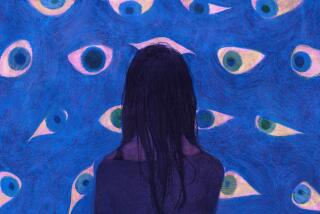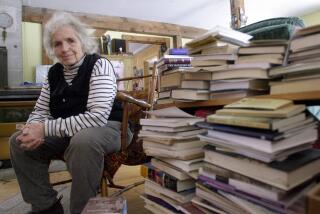Hidden in plain sight
There’s a poster on the wall of an Islamic dress shop in East London showing a young woman in a black hijab. Above her is the word “Pure.” The saleswoman who is helping me also has a scarf covering her head.
I’m here to buy a hijab too -- but that’s not all. I’m here for the full Islamic covering, the complete three-piece suit: the hijab that I will wrap around my head, the shapeless robe known as an abaya, and the now-terribly-controversial niqab -- a square of material that goes over one’s face with a slit of about five inches for my eyes.
I buy it for $73 and take it all home, but I don’t put it on until the next morning. When I do, I see myself for the first time in full Islamic dress -- and I’m horrified. I have disappeared, and somebody I don’t recognize is looking back at me. I cannot tell how old she is, how much she weighs, whether she has a kind face or a sad face. Even my own mother couldn’t recognize me.
I’ve seen this shrouded figure in news reports from the mountains of Afghanistan and the cities of Saudi Arabia, but she looks out of place here in my bedroom in West London. In fact, I feel so dissociated from my own reflection that it takes me over an hour to pluck up the courage to leave the house.
I’ve never worn the niqab before. Growing up in a Muslim household in Bradford, a city in the north of England, in the 1970s and ‘80s, I dressed modestly. But my hair was only covered in the presence of the imam and while I was reading the Koran. Today, however, things have changed. I see second- and third-generation British Muslims concealed in black. They say they wear the niqab voluntarily, to demonstrate their dedication to Allah and to protect them from male eyes.
In recent weeks, this dress code has become the focus of an intense debate that has gripped Britain. It began when Jack Straw, a former British foreign secretary and member of Parliament for Blackburn (a town with a high percentage of Muslims) started the ball rolling. He revealed that he asks Muslim women to remove their veils when they visit him because it makes him feel uncomfortable. These comments were, needless to say, incendiary, and Prime Minister Tony Blair added to the controversy when he described the item of clothing as a “mark of separation.”
As I head onto the street, it takes just seconds for me to become the object of attention. I quickly discover that there are different categories of stares. The one favored by elderly people is to glare directly; women wait until you’ve passed and then turn around when they think you can’t see; men look out of the corner of their eyes, and children just stare, point and laugh blatantly.
I’m having coffee with a friend. I’m finding it hard to breathe. There is no inlet for air (although the material itself is somewhat porous), and I can feel the heat of every breath I exhale. Plus the slit for my eyes keeps slipping down, so I can barely see a thing. My peripheral vision is obscured, as if I were stuck in a car that is completely buried in snow with only a tiny sliver of clean windscreen. I can’t fathom a way of drinking my cappuccino, and when I become aware that everybody in the coffee shop is staring at me, wondering how I’m going to do it, I give up.
At the supermarket, a baby no more than 2 years old takes one look at me and bursts into tears.
After a few hours, I get used to the gaping and the sniggering. But what does surprise me is what happens when I head into central London. I have arranged to meet a friend at the National Portrait Gallery. In the 15-minute walk from the bus stop to the gallery, two things happen. A man in his 30s stops in front of me and asks: “Can I see your face?”
“Why do you want to see my face?” I ask.
“Because I want to see if you are pretty. Are you pretty?”
Before I can reply, he shouts: “You ----ing tease!”
I’m completely taken aback.
Just as I’m thinking about this, I hear the impatient beeping of a horn. A middle-aged man is behind the wheel of a van, leering at me. “Watch where you’re going, you stupid Paki!” he screams. This time I’m a bit faster.
“How did you know I’m Pakistani, underneath all of this?” I shout at him. He responds by driving so close past me that when he yells “Terrorist!” I can feel his breath on my veil.
Things don’t get much better at the National Portrait Gallery. Art lovers pay as much attention to me as they do to the paintings. I might as well be one of the exhibits. Maybe they’re trying to come to grips with the irony of a faceless woman staring at faces.
I float from room to room, like some apparition, looking at paintings of Queen Anne and Mary II. They’re in extravagant ermines and taffetas, and their ample bosoms are on display. All I can think is that if all women dressed in the niqab, how sad and how strange this place would be.
I miss seeing my own face, my own shape. Yet at the same time I feel completely naked. The women I have met who have taken to wearing the niqab tell me that it gives them confidence, but I find that it saps mine.
Nobody has forced me to wear it, but I feel as though I have oppressed myself and isolated myself.
Maybe I’d feel more comfortable being so covered if I were among women who dress in a similar fashion? I head to the Central Mosque in Regents Park.
Hundreds of women are seated on the floor. I look up and down the lines of worshipers. Of course the women here have their heads covered, but I am the only person wearing the niqab. Everyone else’s face is visible. The woman next to me explains that the niqab is seen as “extreme.”
“Allah gave us faces, and we should not hide them,” she says.
I’m reassured by her words. I think deep down my anxiety about having to wear the niqab, even for a day, was based on guilt -- that I am not a true Muslim unless I cover myself from head to toe. But the Koran says: “Allah has given you clothes to cover your shameful parts, and garments pleasing to the eye. But the finest of all these is the robe of piety.”
I don’t understand the need of women to wear something as severe as the niqab. But for that tiny number that do, I will shake their gloved hands for bearing this endurance task -- the staring, the swearing and the discomfort. On the streets of London, the black veil does nothing to distract attention -- and everything to attract it.
More to Read
Sign up for Essential California
The most important California stories and recommendations in your inbox every morning.
You may occasionally receive promotional content from the Los Angeles Times.










